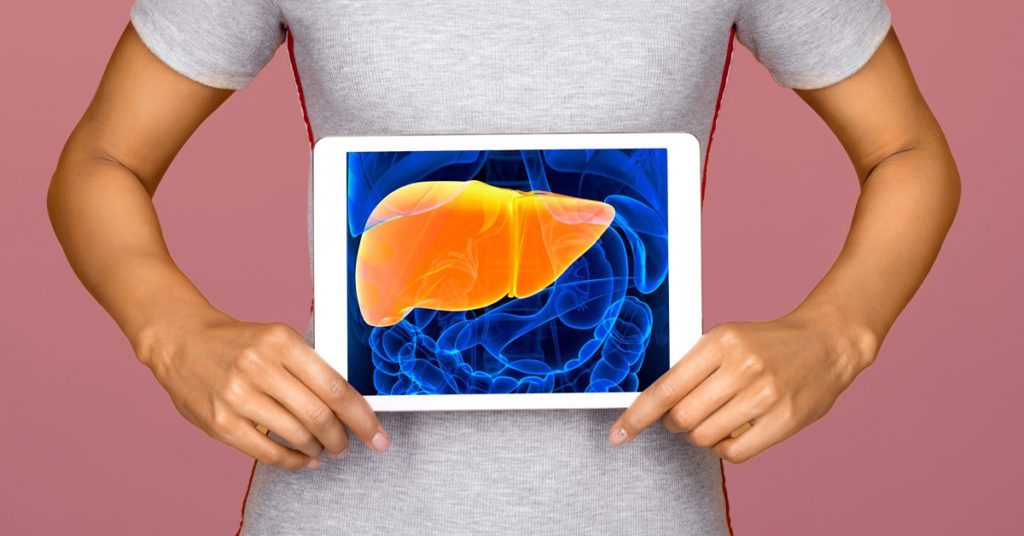Would You Know if You Have Fatty Liver Disease?
The second-largest organ in the human body, the liver processes nutrients and filters impurities from your blood. Too much liver fat can cause dangerous complications, including inflammation and scarring that can lead to liver failure. As high cholesterol, obesity and Type 2 diabetes increase in the U.S., so does the prevalence of fatty liver disease.
People can develop two main types of fatty liver disease: alcoholic fatty liver disease (AFLD) and nonalcoholic fatty liver disease (NAFLD). Nonalcoholic fatty liver (NAFL) and nonalcoholic steatohepatitis (NASH) are two types of NAFLD. AFLD occurs in people who are heavy alcohol drinkers. Female heavy drinkers and those who are obese or have specific genetic mutations are at an increased risk for developing the disease.
NAFLD/NASH, a buildup of fat in the liver, occurs frequently. NAFLD can be harmless initially, but it does cause the liver to swell. Over time, this swelling can cause scarring in your liver, also known as cirrhosis. The more scarring your liver has, the less effectively it functions. NAFLD affects upwards of 25% to 30% of adults in the U.S. and Europe and is now the most common chronic liver disorder in the U.S.
Causes of fatty liver disease
NAFLD can occur alongside insulin resistance, which can make it difficult for your body to regulate sugar. Research shows that people who develop NAFLD:
- Are middle-aged or older
- Are overweight (have a body mass index of 25 or higher) or obese (have a body mass index of 30 or higher)
- Experience rapid weight loss
- Have been exposed to certain toxins, including some pesticides, solvents and industrial chemicals
- Have hepatitis B or C
- Have high cholesterol
- Have high blood pressure
- Have metabolic syndrome, when you have a combination of high blood pressure, high blood sugar, excess body fat around the waist and/or unhealthy cholesterol levels
- Have Type 2 diabetes or prediabetes
- Have a history of smoking
- Take certain medications
Individuals of Hispanic or Caucasian descent also have a higher risk of developing NAFLD than other ethnic groups.
How to know if you have a fatty liver
NAFLD initially causes no symptoms in most people. Your physician may suspect fatty liver disease in some cases if you experience symptoms such as fatigue, nausea, loss of appetite, unexplained weight loss or weakness accompanied by discomfort in the upper right side of your abdomen. Your physician may consider an imaging study to diagnose fatty liver disease if your liver feels enlarged during a physical exam, if you have jaundice, swelling of the abdomen and lower extremities, or itchy skin, or if he or she suspects you may have cirrhosis. Your physician may ask about your alcohol use and your medications to help determine if you could have NAFLD or AFLD.
Often, physicians discover fatty liver disease by accident during a routine blood test. If your blood work shows high levels of liver enzymes, your primary care physician may refer you to a medical imaging center for further tests.
Touchstone Medical Imaging’s FibroScan ultrasound machine performs transient elastography tests to evaluate the stiffness of your liver, since liver stiffness can indicate fibrosis or scarring. Other ways to diagnose fatty liver disease include the following:
- Abdominal ultrasound may reveal that your liver is swollen. Your physician will use several methods to determine if you have fatty liver disease.
- MRI scanning alone cannot distinguish NASH from NAFLD, but it is used for identifying abnormal fat levels in the liver and monitoring changes in fat levels in combination with specialized software.
- Magnetic resonance elastography combines MRI imaging with sound waves to create an elastogram, an imaging study that shows the stiffness of the body’s organs.
Through the advancements in imaging technology, NAFLD and NASH conditions are better assessed and monitored without the need for invasive biopsies. However, if inconclusive results are determined, your physician may still recommend a liver biopsy.
Treating fatty liver disease
You can address NAFLD through weight loss, by following a healthy diet and getting regular exercise, according to the National Institute of Diabetes and Digestive and Kidney Diseases. These changes may be enough to reverse NAFLD in its earliest states, according to the American Liver Foundation. Because some medications can also cause NAFLD, your physician may recommend you stop taking them or change to a different medication. Always tell your physician what dietary supplements you take, including vitamins, as some herbal ingredients have been associated with liver damage.
The U.S. Food and Drug Administration has not approved any medical therapies to treat NASH, but clinical trials are currently underway.
A safe, comfortable imaging experience
Touchstone Medical Imaging provides patients and physicians the highest quality outpatient imaging services, while allowing you to avoid complex hospital systems. We work with leading radiologists and invest in innovative technologies in each region, so you experience exceptional care and receive highly reliable imaging results. Our fellowship-trained, subspecialty radiologists complete advanced training that allows them to detect the subtle irregularities in imaging studies that others without their expertise may miss.
Our freestanding imaging centers can provide all your imaging needs in a safe, comfortable, outpatient environment. We deliver results within hours, so your referring physician will quickly have the reliable information he or she needs to determine the optimal treatment for you.
Touchstone Medical Imaging offers FibroScan Ultrasound and MRI imaging with LiverMultiScan® technology at centers throughout Arkansas, Colorado, Florida, Montana, Nebraska, Oklahoma and Texas, with same-day and next-day appointment options available at many of our locations. Get a referral from your physician, and then find the Touchstone Medical Imaging center near you to schedule an appointment.

